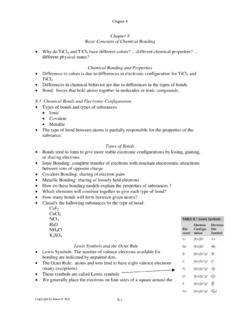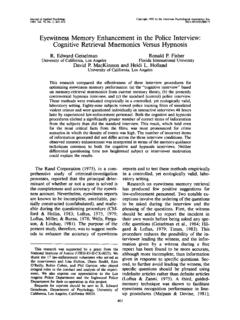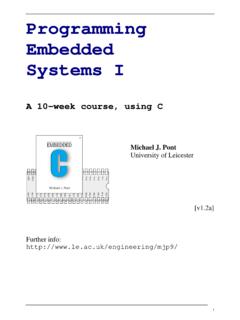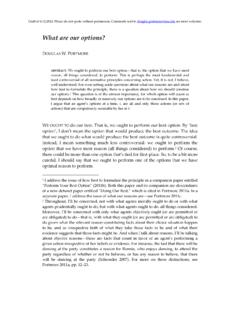Transcription of Accounting for Equity Investments & Acquisitions
1 1 Accounting for Equity Investments & Acquisitions % of Outstanding Voting Stock Acquired0%20% 50% 100%Nominal Significant ControlFair Value Equity methodInvestment account ConsolidateLevel ofInfluenceValuationBasisBalanceSheet2 Equity Method - Introduction Records the initial purchase of an investment at acquisition cost Each period, the investor captures its proportionate share of the periodic earnings Not the dividends of the investee Investor treats dividends declared by the investee Reduction in the investment Method - Rationale Why not mark-to-market such Investments ?
2 Under the market value method for securities available for sale, the investor recognizes income statement effects only when it receives a dividend (revenue) or sells some of the investment (gain or loss).3 Example Equity Method 12/31/2003 XYZ Inc. purchases 40% of the outstanding shares of ABC Inc. for $ Book value of ABC = market value at this date ($ 3M) At 2004 ABC reports income of $250,000 and pays dividend of $100,000 At 2005 ABC reports earnings of $500,000 and pays dividends of $225,000 How and in what amount should this investment be presented on XYZ s balance sheet on December 31, 2004 and 2005?
3 Journal Entries: At the Acquisition DateInvestment in ABC s stock 1,200,000 Cash1,200,000 Record the acquisition of 40% of ABC Inc. 1,200,000=40% x 3,000,0004 Year 2004 investment in ABC stock100,000 Equity in Earnings of Affiliate100,000 To record XYZ s share in the income earned by ABCCash40,000 investment in ABC stock40,000 To record dividends received from ABCYear 2005 investment in Stock of ABC200,000 Equity in Earnings of Affiliate200,000 To record XYZ s share in the income earned by ABCCash90,000 investment in Stock of ABC 90,000 To record dividend received from Sheet Looks Firm XYZ s investment in ABC account now has a balance of $1,370,000 by the end of 2005.
4 Balance 1,370,00040,000 (3)90,000 (5)(1) 1,200,000(2) 100,000(4) 200,000 investment in Stock of ABCC onsolidation Accounting In a business combination, one company (ParentParent) gains controlover another company (SubsidiarySubsidiary) Until 2001, two consolidation methods were used for mergers and Acquisitions Purchase method Pooling of interests method In 2001, the FASB discontinued the pooling method (Statement 141)6 Meaning of Control An entity that has the ability to elect a majority of the board of directors of another entity has controlcontrolover it Control enables the parent.
5 Direct the sub to expand, contract or distribute cash to the parent Establish the sub financing structure Fire and hire the sub management Set compensation level for the sub of Control Legal ControlLegal Control Owning more thanmore than50% of the subsidiary s outstanding voting stock Parent has the legal right to elect the majority of the board of directors Effective ControlEffective Control Majority of the board of directors can be elected by means other then having legal Categories of Combination MergerMerger One firm acquires the assets and liabilities of one or more other
6 Firms in exchange for cash, stock or other compensation Acquired firm ceases to exist as a separate legal entity 100% ownership Statutory ConsolidationStatutory Consolidation New firm is formed to issue stock in exchange for the stock of the two or more consolidating firms Acquired firms cease to exist as separate legal entities 100% Categories of AcquisitionAcquisition One firm acquires the majority of the common stock of another company and each company continues its legal existence Each company must be accounted for separately and prepare its own set of financial statements
7 Financial statements are then consolidatedConsolidatedConsolidatedfina ncialfinancialstatementsstatements-combi nation of the financial statements of the parent company with those of the subs an overall report asasififthey were a singlesingleentityThree Categories of Process Eliminating worksheet entries are made to reflect the two separate companies statements as one economic entry No consolidation elimination entries are recorded on the books of either the parent or the subsidiary. 9 Consolidation - Rationale Economically, the parent has the power to liquidate the subsidiary into a branch In this case the current legal structure of two separate companies will cease to exist.
8 Thus, the parent and the sub are treated as a single legal Method Business combinations Use the purchase methodpurchase method Acquisitions are measured on the basis of the fair valuesfair valuesexchanged. 10 Consolidation: Wholly-Owned SubsidaryBefore the purchaseACorporationBCorporationBShareho ldersAShareholdersAfter the PurchaseAShareholdersB CorporationA CorporationWholly-Owned Subsidiaries Parent s perspective Purchase exchange of one asset for another, usually cash for the stock of the subsidiary Consolidated net income = parent s net income. Consolidated retained earnings = parent s retained earnings Sub.
9 S retained earnings Eliminated in Subsidiaries If parent company owns < 100% of sub Minority interest exists Calculated using book value of acquired firm Balance sheet reflects the rights of non-majority shareholders in the assets and liabilities of a company that is consolidated into the accounts of the major shareholder Appears after long-term debt but before stockholders Equity (quasi liability). Minority income Income statement reflects the share of non-majority shareholders in the earnings of a the consolidated firm Appears as a line item 80% Owned SubBefore the PurchaseACorporationBCorporationBShareho ldersAShareholdersAfter the PurchaseAShareholdersB CorporationA CorporationSome of formerB shareholdershold 20% of B12 Purchased Goodwill Goodwill Goodwill Excess of the cost of an acquired company over the sum of the fair market value of its net identifiable individual assets Goodwill usually results from one or more of the following.
10 Brand name Good employees Customer loyalty Monopoly & Measurement of Goodwill Dictated by Statement No. 142: Goodwill and Other Intangible Assets (July 20, 2001) Goodwill should not be amortized Tested for impairment at a level of reporting referred to as a reporting unit Reporting unit operating segment or one level below an operating segment A component of an operating segment is a reporting unit if the component constitutes a business for which discrete financial information is available and segment management regularly reviews the operating results of that component Impairment exists when the carrying amount of goodwill exceeds its implied fair value.
















